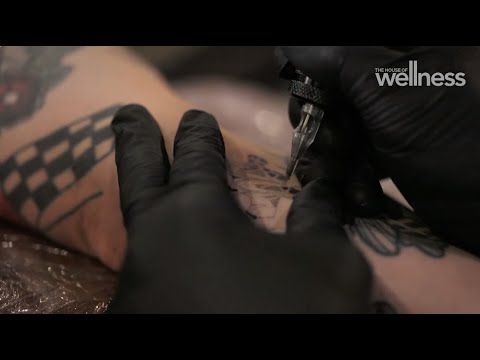The Re-emergence of Tramp Stamp Tattoos: Empowerment or Stigma?
Once cool, then mocked, tramp stamp tattoos are making a comeback. These lower-back tattoos carry a history of stigma and sexualization. This blog will explore how the tramp stamp has shifted from a taboo to a statement of empowerment.
Stay tuned for an eye-opening read!
Key Takeaways
- Tramp stamp tattoos, once stigmatized as a symbol of promiscuity, are being reclaimed by Gen Z as a form of empowerment and self-expression, challenging societal norms and stereotypes.
- The resurgence of tramp stamp tattoos signifies a cultural shift towards body autonomy and personal choice in body art, encouraging individuals to embrace their unique forms of self-expression without judgment.
- Individuals with tramp stamps are asserting their pride in reclaiming control over their bodies, highlighting the diverse reasons behind their choice and debunking stereotypes associated with this placement.
The History of Lower-Back Tattoos
The term “tramp stamp” originated in the early 2000s to describe tattoos on women’s lower backs, often associated with social stigma and stereotyping. However, there is a growing movement to reclaim these tattoos as symbols of empowerment and self-expression.
Origin of the term “tramp stamp”
Lower-back tattoos gained a notorious nickname in the late ’90s and early 2000s. People started calling them “tramp stamps” as a snide commentary on women’s sexuality. This label implied that women with such tattoos were promiscuous, feeding into gender stereotypes and societal judgments about female body autonomy.
Media representations often exacerbated this stigma by portraying lower-back tattoos as symbols of erotic appeal rather than personal expression or art.
Society used this derogatory term to police women’s choices, suggesting they lacked professionalism or respectability if they sported ink on their lower back. However, individuals who chose this form of body modification did so for diverse reasons, from aesthetic preference to meaningful symbolism.
Over time, these tattoos moved beyond being a fashion trend; they became part of larger conversations about feminism and reclaiming control over one’s own body despite persistent stigmatization and cultural taboos surrounding tattoo culture.
Social stigma surrounding lower-back tattoos in the past
The media and societal perspectives have long sexualized and stigmatized lower-back tattoos, often referred to as “tramp stamps.” Women who opted for this placement faced judgment and shaming due to the negative connotation attached to these body arts.
The patriarchal influence in labeling them as “tramp stamps” further perpetuated the stigma surrounding lower-back tattoos, leading to misconceptions about the individuals choosing such placements.
This historical stigma has contributed to a reevaluation of cultural perceptions and judgments regarding body art and self-expression. However, the resurgence of tramp stamp tattoos is sparking conversations about empowerment and challenging society’s stigmatization, paving the way for a movement that reclaims body autonomy while acknowledging past prejudices.
The Re-emergence of Tramp Stamp Tattoos
Gen Z has embraced the trend of lower-back tattoos, reclaiming the tramp stamp as a symbol of empowerment rather than stigma. This resurgence challenges traditional social norms and celebrates personal choice in body art.
Gen Z’s embrace of the trend
Gen Z is challenging the negative narrative surrounding tramp stamp tattoos by embracing this trend, reclaiming body autonomy and self-expression. Their embrace of lower-back tattoos reflects a movement towards empowering individuals to make their own choices about body art, free from societal judgment or stereotypes.
This generation’s rejection of traditional beauty standards has contributed to the resurgence of tramp stamps as symbols of personal empowerment and self-expression.
Moving beyond Gen Z’s perspective, it’s essential to explore personal experiences with lower-back tattoos and debunk stereotypes associated with this form of body art.
Reclaiming the tramp stamp as a symbol of empowerment
As Gen Z embraces the trend of tramp stamp tattoos, a powerful movement is underway to reclaim this placement as a symbol of empowerment. Despite the historical stigmatization and sexualization attached to lower-back tattoos, individuals are challenging these perceptions and proudly embracing their body art.
Women who have been judged for their tramp stamps are speaking out about their experiences, rejecting the negative connotations associated with this tattoo placement. This resurgence has sparked conversations about self-expression and autonomy, reshaping cultural perceptions and empowering individuals to embrace their decision to get inked in that particular location.
The re-emergence of tramp stamp tattoos signifies a shift towards self-empowerment and challenges the societal taboos surrounding body art. People are rejecting the historical stigma attached to lower-back tattoos and choosing to express themselves without shame or judgment.
Additionally, as older generations who initially popularized this trend reclaim its beauty, they contribute significantly to reshaping perceptions and advocating for body autonomy.
Personal Perspectives
Individuals with tramp stamps share their thoughts and experiences, highlighting the need to debunk stereotypes associated with the tattoo. Their perspectives offer an insight into the reclaiming of tattoos as a form of self-expression and empowerment.
Opinions from those who have tramp stamps
Individuals with tramp stamps express pride in their decision to get inked on their lower back, rejecting the stigma associated with this placement. They feel empowered by reclaiming control over their bodies and honoring their self-expression. Here are some opinions from those who have tramp stamps:
- Embracing Self-Expression: Many individuals view their tramp stamps as a form of self-expression and personal empowerment, asserting that it represents their individuality and autonomy.
- Challenging Stigmas: Those with tramp stamps speak out against the societal stigmatization of lower-back tattoos, emphasizing that it’s a personal choice and does not define one’s character or worth.
- Reclaiming Beauty: Some individuals express pride in the beauty of their tramp stamps, highlighting the artistic and meaningful aspects of their chosen tattoo placement.
- Defying Stereotypes: People with tramp stamps defy stereotypes and misconceptions, asserting that they do not conform to society’s narrow standards of beauty or behavior.
- Cultural Reclamation: Many see their lower-back tattoos as a means of reclaiming cultural perceptions of body art, challenging historical biases and fostering a sense of empowerment through redefining beauty norms.
- Asserting Autonomy: Individuals emphasize that getting a tramp stamp is an act of autonomy and agency over one’s body, rejecting external judgment and reclaiming ownership of personal choices.
- Empowerment through Visibility: Those with tramp stamps feel empowered by openly displaying their body art, refusing to hide or be ashamed of a tattoo that holds personal significance for them.
Debunking stereotypes associated with the tattoo
Reclaiming lower-back tattoos allows individuals to challenge societal norms and express their autonomy over their bodies. The resurgence of tramp stamp tattoos dispels the misconception that they are exclusively associated with promiscuity or low self-worth, highlighting instead the diverse reasons behind individuals’ choice to get inked in this area.
By embracing these tattoos, people debunk the stereotype that lower-back art is solely about conforming to beauty standards or seeking attention.
This reclamation movement empowers individuals to take pride in their body art without feeling compelled to conform to society’s preconceptions. It provides an avenue for personal expression and defies the narrow-minded assumptions imposed on those with lower-back tattoos.
Embracing this form of self-expression invites a new perspective into what has long been stigmatized, encouraging a discourse about individual empowerment and autonomy over one’s body.
The Impact on Beauty and Fashion
The popularity of tramp stamps in the 2000s had a significant impact on the beauty industry, with lower-back tattoos becoming a symbol of feminine allure. Today, this trend continues to influence fashion and beauty standards.
The popularity of tramp stamps in the 2000s
Tramp stamps gained popularity in the early 2000s, with many women opting for lower-back tattoos as a trendy and fashionable choice. Celebrities like Britney Spears and Pamela Anderson flaunted their lower-back tattoos, influencing a surge in demand for this placement.
The allure of tramp stamps was fueled by their discreet yet alluring location, contributing to their widespread appeal among young adults seeking self-expression through body art.
The trend’s resurgence has ignited discussions about reclaiming the beauty of tramp stamp tattoos, challenging societal perceptions and emphasizing personal empowerment through self-expression.
The trend’s current relevance in the beauty industry
Revisiting the popularity of tramp stamps in the 2000s, it’s evident that lower-back tattoos have resurfaced as a significant trend in the beauty industry. With social media influencers and celebrities proudly showcasing their lower-back tattoos, this placement has garnered renewed attention and interest.
Beauty brands are also embracing this trend, creating makeup and body products specifically designed to accentuate lower-back tattoos, contributing to its current relevance in the beauty industry.
Additionally, tattoo artists specializing in intricate designs for this area are gaining recognition and demand from individuals looking to adorn their lower backs with unique and beautiful artwork.
Conclusion: Empowering or Stigmatizing?
In conclusion, the re-emergence of tramp stamp tattoos challenges societal stigmas and promotes self-empowerment among individuals choosing this body art. Gen Z’s embrace of this trend reflects a shift towards reclaiming the beauty and significance of lower-back tattoos.
The movement to redefine tramp stamps as symbols of empowerment highlights a cultural shift in perceptions surrounding body art and self-expression. This resurgence signifies a step towards breaking free from historical stigmatization, allowing individuals to embrace their unique forms of self-expression without judgment.
FAQs
1. What does the term “tramp stamp tattoo” refer to?
The term “tramp stamp tattoo” commonly refers to a tattoo located on the lower back of a person’s body, which gained popularity and also faced stigmatization.
2. Why are lower back tattoos making a comeback?
Lower back tattoos are reclaiming popularity as people, including female celebrities, embrace them for self-expression and empowerment through tattoos.
3. How do these tattoos challenge the patriarchy?
Reclaiming tramp stamp tattoos can be seen as an act against the patriarchy in the tattoo industry by asserting control over one’s body art and its cultural significance.
4. Is there still stigma attached to having a tramp stamp tattoo?
Yes, some people still view lowerback tattoos as taboo or attach stigmatization despite growing movements that promote empowerment and feminist ideals.
5. Have celebrities had an impact on this trend in tattoos?
Absolutely! Celebrity influence on tattoo trends has played a significant role in reviving interest in these types of intimate body art with erotic appeal.





